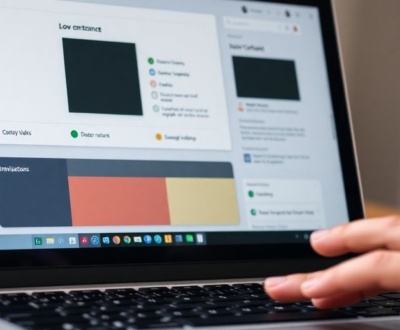So, you’re building web components, huh? That’s cool. They’re super useful for making reusable bits of your website. But then you hit a wall: styling. It’s like, how do you make your component look good without messing up everything else on the page? And how do you let other people change how it looks without them totally breaking your carefully crafted design? It’s a bit of a puzzle, but don’t worry. We’re gonna go through some ways to make your web components look awesome while keeping everything neat and tidy. We’ll talk about how to get around some common styling headaches with web components styling, and keep that encapsulation thing going strong.
Key Takeaways
- Web components styling uses Shadow DOM for isolation, which means styles inside won’t clash with outside styles. This is good for making components that work anywhere.
- CSS variables are your friends for web components styling. They let you expose certain style parts so others can change them without messing up your component’s core look.
- Styling content in slots can be tricky because it lives in the main document. Use the `::slotted()` selector, but remember it only works for direct children, not stuff nested deeper.
- You can control animations and other advanced features in web components styling by using custom properties. This lets users tweak things like timing or colors.
- Always test your web components styling in different browsers. Shadow DOM can act a little different depending on the browser, so check to make sure your components look consistent everywhere.
Understanding Web Components Styling Encapsulation

The Core Purpose of Shadow DOM
The Shadow DOM is a game-changer in web development. It’s all about creating true component isolation. Think of it as a mini-DOM inside your main DOM, but completely shielded. This means styles and scripts defined within a Shadow DOM don’t leak out and mess with the rest of your page, and vice versa. It’s like having a separate, self-contained world for your component. This is a key feature of Web Components, which allows developers to create reusable, self-contained components.
Benefits of Encapsulated Web Components Styling
Encapsulation brings a ton of advantages. First off, it prevents style conflicts. No more worrying about global CSS rules accidentally overriding your component’s styles. It also promotes reusability. You can drop your component into any project, knowing its styles will stay consistent. Plus, it makes your code more maintainable. Changes inside the Shadow DOM won’t have unexpected side effects elsewhere. Here’s a quick rundown:
- Prevents style conflicts
- Enhances component reusability
- Improves code maintainability
Encapsulation is not just a nice-to-have; it’s essential for building robust and scalable web applications. It allows developers to create independent, self-contained components that can be easily reused and maintained across different projects.
Why Encapsulation Matters for Web Components Styling
Without encapsulation, styling web components would be a nightmare. Imagine trying to manage styles for hundreds of components, all potentially conflicting with each other. Encapsulation provides a clear boundary, making styling predictable and manageable. It allows component authors to define styles that are specific to their component, without having to worry about external interference. This is especially important when integrating third-party components or working on large teams. It’s about creating a stable and predictable styling environment. It also allows you to expose CSS custom properties for styling.
Overcoming Styling Limitations with CSS Variables
Web Components offer great encapsulation, but sometimes that encapsulation makes styling a bit tricky. You might find yourself wanting to tweak the look of a component from the outside, without messing with its internal structure. That’s where CSS variables come to the rescue. They let you expose certain styles for customization, giving developers the flexibility they need while still keeping the component’s core styling safe and sound.
Exposing Customizable Styles for Web Components
The key is to think about what aspects of your component’s styling might need to be changed by someone using it. Maybe it’s the primary color, the font size, or the padding around certain elements. By exposing these as CSS variables, you’re essentially creating a set of ‘hooks’ that can be tweaked from the outside. This approach keeps the component self-contained while still allowing for a good degree of customization.
Implementing CSS Custom Properties for Flexibility
To implement this, you define CSS custom properties inside your component’s shadow DOM. These are variables that start with --, like --primary-color or --font-size. You then use the var() function to apply these variables to your styles. The cool thing is, you can also provide a default value in case the variable isn’t defined externally. This ensures that your component always has a fallback style, even if no customizations are provided.
For example:
:host {
--primary-color: blue;
--font-size: 16px;
}
h1 {
color: var(--primary-color, black); /* Default to black if --primary-color isn't set */
font-size: var(--font-size, 14px); /* Default to 14px if --font-size isn't set */
}
Dynamic Styling with CSS Variables in Web Components
CSS variables aren’t just for static styling; they can also be used for dynamic styling. You can change the value of a CSS variable using JavaScript, and the component will automatically update its appearance. This opens up a lot of possibilities for creating interactive and responsive components. For instance, you could change the color of a button when it’s clicked, or adjust the size of an element based on the screen size. The dynamic styling capabilities are pretty powerful.
Think of CSS variables as a bridge between the inside and outside of your web component. They allow you to control the flow of styling information, giving you the best of both worlds: encapsulation and customization. It’s a way to make your components more adaptable and reusable in different contexts.
Here’s a simple example of how you might use JavaScript to change a CSS variable:
const myComponent = document.querySelector('my-component');
myComponent.style.setProperty('--primary-color', 'red');
This would change the primary color of the my-component element to red. Pretty neat, huh?
Styling Slotted Content in Web Components

One of the trickier parts of working with web components is styling content that’s passed into them using slots. It’s not always obvious how to do it, and there are some limitations you need to be aware of. The Shadow DOM creates a boundary, and slotted content lives in the light DOM, which can make things complicated.
Addressing the Inability to Style Slotted Content
So, you’ve got a web component, and you’re using slots to let people inject their own HTML into it. Great! But what if you want to style that injected content from within your component’s Shadow DOM? That’s where things get interesting. The main challenge is that slotted content technically lives outside the Shadow DOM, making it seem like you can’t touch it with your component’s internal styles.
Leveraging the ::slotted() Pseudo-Element
Thankfully, CSS provides a special tool for this: the ::slotted() pseudo-element. This lets you target elements that are slotted into your component and apply styles to them from within the Shadow DOM. It’s like a bridge between the inside and outside worlds. For example, if you want to make all <h1> elements slotted into your component red, you can use ::slotted(h1) { color: red; }. This is the only way to apply styles from the Shadow DOM to elements passed through slots.
Limitations of ::slotted() for Nested Elements
While ::slotted() is super useful, it does have a limitation: it only works on direct children of the slot. You can’t use it to target nested elements within the slotted content. So, if you have a <div> slotted in, and you want to style a <p> inside that <div>, ::slotted() won’t directly work. You might need to get creative with CSS variables or consider restructuring your component’s template structure to work around this limitation.
Dealing with slotted content can be a bit of a puzzle. You have to think about where the content lives (light DOM) and where the styles are defined (Shadow DOM). ::slotted() is your friend, but remember its limitations. Sometimes, the best approach is to design your component with these constraints in mind from the start.
Advanced Techniques for Web Components Styling
Controlling Animations with Custom Properties
Web components, with their Shadow DOM, offer great encapsulation, but sometimes you need to tweak animations from the outside. CSS custom properties (variables) are your friend here. They let you control animation aspects like timing or effects without breaking the component’s internal structure. For example, you can define a --animation-duration variable inside your component’s style and then change it from the main page’s CSS. This way, you keep the animation logic inside the component but allow for external adjustments.
Ensuring Consistent Behavior Across Browsers
Shadow DOM implementation can vary a bit across different browsers. What looks perfect in Chrome might have slight differences in Firefox or Safari. To avoid headaches, always test your components in multiple browsers. Use tools like BrowserStack or Sauce Labs to automate this process. Also, consider using polyfills for older browsers that don’t fully support Shadow DOM. This ensures a consistent user experience regardless of the browser they’re using. Here’s a quick checklist:
- Test on Chrome
- Test on Firefox
- Test on Safari
- Use polyfills if needed
It’s a good idea to set up automated tests that run on different browsers whenever you make changes to your components. This helps catch any inconsistencies early on and prevents surprises later.
Enhancing Customization in Shadow DOM
One of the challenges with web components is allowing users to customize their appearance without breaking encapsulation. Exposing CSS custom properties is a great way to do this. Let’s say you have a component with a heading. You can define a --heading-color variable inside the component’s Shadow DOM and then let users override it from their own CSS. This gives them control over the heading’s color without having to dig into the component’s internals. It’s a win-win situation: you maintain encapsulation, and users get the customization they want. You can even use JavaScript to dynamically update these properties based on user interactions. This allows for even more advanced customization options. Think about it like this:
| Property | Description |
|---|---|
--heading-color |
Controls the color of the heading. |
--font-size |
Adjusts the font size of the component’s text. |
--border-radius |
Modifies the border radius of the component. |
Managing Style Inheritance in Web Components
Web components, with their Shadow DOM, give us great encapsulation, but this can also make style inheritance a bit tricky. It’s all about finding the right balance between keeping things separate and allowing some level of global style influence. Let’s explore how to manage this.
Preventing Global Style Interference
One of the main goals of using Shadow DOM is to prevent global styles from messing with the internal styling of your component. This ensures that your component looks and behaves the same no matter where it’s used on a page. However, sometimes global styles can bleed through in unexpected ways, especially with things like font styles or basic element styles. To combat this, you can use techniques like setting explicit styles within your component to override any potential inherited styles.
Maintaining Visual Consistency Across Applications
While preventing interference is important, you also want your web components to fit in with the overall look and feel of your application. This is where CSS variables come in handy. By exposing certain style properties as CSS variables, you allow developers to customize the appearance of your component without breaking its encapsulation. Think of it as providing a set of knobs and dials that they can adjust to match their design system. For example, you can expose CSS custom properties for colors, fonts, and spacing.
Integrating Third-Party Components Seamlessly
When you’re using third-party web components, you often have little control over their internal styling. This can lead to visual inconsistencies if the component doesn’t match your application’s style. One approach is to use CSS resets or normalize styles within your application to provide a consistent base for all components. Another is to use CSS variables to override the component’s default styles, if the component exposes them. It’s also worth checking if the third-party component offers any styling options or themes that you can use to customize its appearance. It’s a bit of a dance, but getting it right makes a huge difference.
It’s important to remember that the Shadow DOM is a powerful tool for creating reusable and encapsulated components, but it’s not a silver bullet. You still need to carefully consider how your components will interact with the rest of your application and provide appropriate styling hooks for customization.
Best Practices for Web Components Styling
Modular and Maintainable Component Styling
When building web components, it’s easy to fall into the trap of creating monolithic style sheets that are hard to manage. The key is to keep your component styles modular and focused. Think of each component as a mini-application with its own styling needs. Break down your CSS into smaller, manageable files, and use naming conventions that clearly indicate the purpose of each style rule. This approach makes it easier to update and maintain your components over time. Modularity is key.
- Use a CSS preprocessor like Sass or Less to organize your styles.
- Adopt a BEM (Block, Element, Modifier) or similar naming convention.
- Keep your CSS files small and focused on a single component or aspect of a component.
By keeping your styles modular, you’ll find it easier to reuse components across different projects and maintain a consistent look and feel throughout your application.
Future-Proofing Projects with Shadow DOM
Shadow DOM provides a powerful way to encapsulate styles, but it’s important to consider how your components will behave as web standards evolve. One of the best ways to future-proof your projects is to rely on CSS variables for customization. This allows developers to easily override styles without having to dig into the component’s internal structure. Also, make sure to test your components across different browsers to ensure consistent behavior. reusable, encapsulated HTML tags are a great way to future-proof your projects.
- Use CSS variables for theming and customization.
- Test your components across different browsers.
- Stay up-to-date with the latest web standards.
Building Robust and Beautifully Styled Interfaces
Creating robust and beautifully styled interfaces with web components requires a combination of technical skill and design sensibility. It’s not enough to simply get the styles working; you also need to consider the user experience. Think about how your components will be used in different contexts and design them to be flexible and adaptable. Pay attention to details like typography, spacing, and color palettes to create a visually appealing and engaging experience. A well-designed component library can significantly improve the overall quality of your web applications.
- Prioritize user experience in your design decisions.
- Pay attention to details like typography and spacing.
- Create a consistent design language across all your components.
Wrapping Up: Getting Good at Shadow DOM Styling
So, styling web components with Shadow DOM means you have to think a bit differently. It really locks things down, which is great for keeping styles from messing with each other and making components you can use anywhere. But yeah, that isolation can also throw some curveballs. If you get how it works and use the tricks we talked about here—like CSS variables, the ::slotted() thing, and keeping animations contained—you can totally get good at styling web components. You’ll end up with stuff that’s not just strong and easy to reuse, but also looks good. We think making things modular and easy to keep up is where web design is headed. So, by getting a handle on Shadow DOM styling, you’re not just getting your projects ready for the future, you’re also making sure your components look sharp.
Frequently Asked Questions
What exactly is Shadow DOM and why is it important for web components?
Think of Shadow DOM like a secret room inside your web page. Whatever you put in that room (like styles or code) stays hidden and doesn’t mess with anything outside. This is super helpful because it keeps your different web page parts from breaking each other’s looks or functions. It’s like having a bunch of self-contained mini-websites on one big page.
How do CSS variables help in styling web components without breaking their privacy?
Sometimes, you want to change how a web component looks without messing up its inner workings. CSS variables are like special labels you can put on certain styles inside your component. This lets people using your component easily change things like colors or sizes from the outside, without having to dig into the component’s private code. It’s a neat trick for making components flexible.
I’m having trouble styling content that goes into a web component’s slot. What’s the deal with that `::slotted()` thing?
When you put content into a ‘slot’ in your web component, that content technically lives outside the component’s private Shadow DOM. This makes it tricky to style directly. The `::slotted()` trick lets you reach into the slot and apply styles to the things placed there. But remember, it only works for the direct items in the slot, not for things nested even deeper inside them.
Can I control animations within a web component using these styling methods?
Yes, you can! By using CSS variables, you can let others control parts of your component’s animations. For example, you could set up a variable that changes how fast an animation runs or what color something turns into during a transition. This gives users a lot of power to customize your component’s animations without you having to write a ton of extra code.
How does this ‘encapsulation’ thing prevent my global website styles from messing with my web components?
The main goal of Shadow DOM is to stop styles from leaking in or out of your components. This means your component’s styles won’t accidentally change other parts of your website, and your website’s main styles won’t mess up your component. It helps keep everything neat and predictable, especially when you’re using components from different sources.
What’s the best way to make sure my web components look good and work well in the long run?
The best way is to always think about your components as small, independent pieces. Use CSS variables to allow for some customization, but keep the core styling inside the Shadow DOM. Always test your components in different web browsers to make sure they look and act the same everywhere. This approach helps you build strong, good-looking components that are easy to use and update.
About this blog
We are a digital marketing company with a focus on helping our customers achieve great results across several key areas.
Request a free quote
We offer professional SEO services that help websites increase their organic search score drastically in order to compete for the highest rankings even when it comes to highly competitive keywords.









